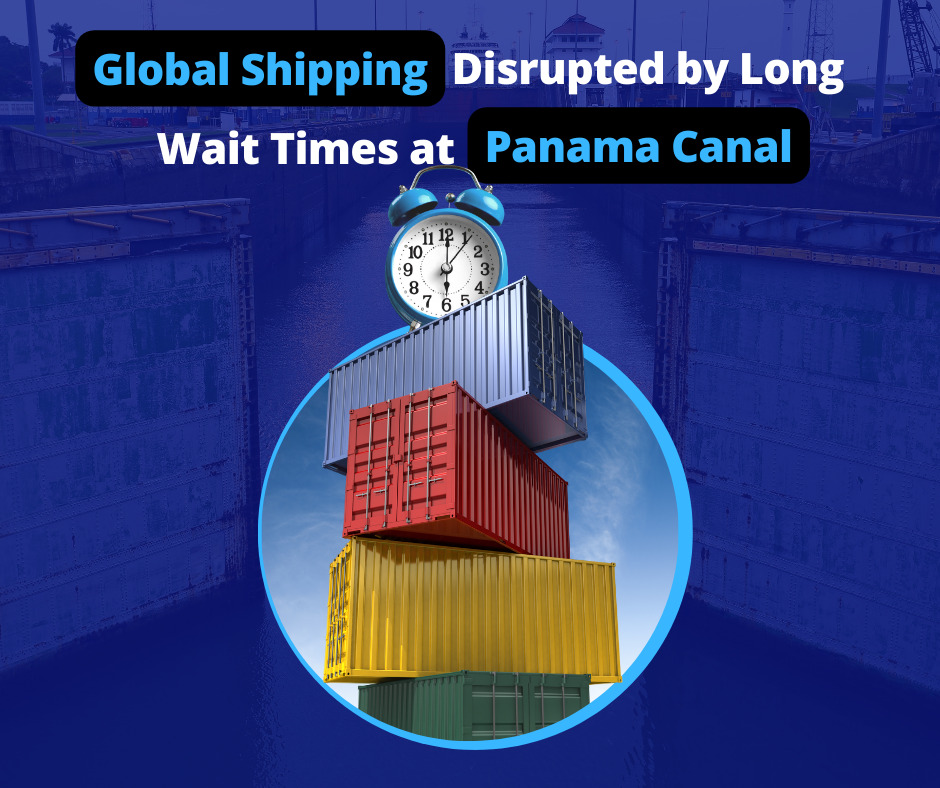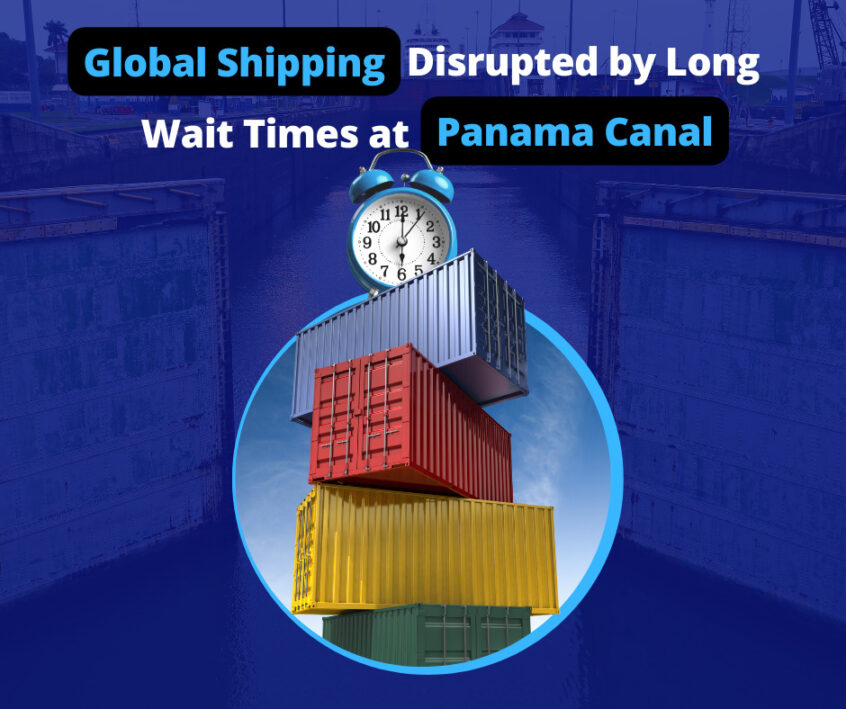
In the web of global trade, the Panama Canal stands as a critical artery, facilitating the movement of goods between the Atlantic and Pacific Oceans. However, recent disruptions are sending ripples through the shipping industry, echoing concerns about prolonged wait times and the need for strategic adaptations. As we explore the matter, the implications for the logistics sector come to light, influencing shipping routes, wait times, and operational costs.
Panama Canal Woes: A Surge in Wait Times
The crux of the issue lies in the escalating wait times for vessels without reservations. This was exacerbated by recent adjustments in the Panama Canal’s operational framework. The Panama Canal Authority (ACP), responding to drought conditions, has reduced daily reservation slots, leading to a domino effect on wait times.
The reservation slot reduction has been quite significant in recent times. At the beginning of November, there were 32 slots available for reservations. However, this number has dwindled to 24, indicating reduced availability of slots. What’s even more concerning is that further cuts are planned, which suggests that the number of reservation slots may continue to decrease.
The surge in wait times for southbound transits without reservations is quite alarming. In a short period, the average wait time has skyrocketed from 2.1 days to a staggering 11.4 days by mid-November. This drastic increase in wait times indicates that more people opt for transit without reservations, leading to overcrowding and delays. It also suggests that the capacity to accommodate these transits is not keeping up with the demand, resulting in longer wait times.
Not only have wait times for southbound transits been affected, but northbound transits have also experienced a significant spike in wait times. On average, the wait time for northbound transits has reached nine days, which is triple the duration observed in early November. This substantial increase in wait times for northbound transits highlights the strain on the transit system and the challenges faced in managing the influx of travelers.
Overall, the reduction in reservation slots and the surge in wait times for southbound and northbound transits are concerning trends. These statistics indicate a growing imbalance between the demand for transit services and the available capacity to meet that demand. Authorities must address these issues promptly and implement measures to alleviate congestion and reduce wait times for a smoother travel experience.
Vessel Categories & Wait Time Disparities
Understanding the dynamics of wait times involves delving into vessel categories and their corresponding wait durations. Notably, the older Panamax locks are witnessing the most extended wait times, affecting regular and supersized vessels.
The Panamax Locks are currently facing challenges resulting in prolonged wait times for regular and supers ships. Regular ships, which have a beam of less than 91 feet, and supers’ ships, which have a beam of 91 to 107 feet, are both experiencing delays. These delays are causing significant disruptions to the transit system and the shipping industry. According to recent statistics, the wait times for these ships are much longer than usual, with some ships waiting for several days before they can pass through the locks.
On the other hand, Neopanamax ships with beams over 107 feet are experiencing relatively shorter wait times. This is in contrast to regular and supers ships facing prolonged waits. Neopanamax ships are larger and have a greater capacity than regular and supers ships, which may explain why they are experiencing shorter wait times. Recent data indicates that the wait time for Neopanamax ships is significantly lower than for other ships, with some waiting for only a few hours before they can pass through the locks.
These statistics suggest that the current challenges the Panamax Locks face are affecting regular and supers ships more than Neopanamax ships. Authorities must address these challenges promptly and implement measures to reduce wait times for all types of ships. The shipping industry is vital to the global economy, and any disruptions to this industry can have far-reaching consequences. Therefore,ensuring that the transit system operates smoothly and efficiently is essential to minimize delays and disruptions.
Impact on Specific Shipping Routes
The repercussions extend beyond mere wait times, significantly influencing shipping routes and the choices made by shipowners.
Alternative routes are becoming increasingly popular for some LNG carriers as they opt for routes around the Cape of Good Hope instead of using the congested Panama Canal. According to recent data, this trend is rising, with more LNG carriers taking this alternative route. The congestion at the Panama Canal is causing significant delays for these carriers, leading them to explore other options. While the route around the Cape of Good Hope is longer, it may be a more viable option for some carriers in terms of time and cost.
Container shipping also faces challenges due to reduced daily reservation slots for Neopanamax container ships. These ships are crucial for U.S. East and Gulf Coast ports, and the reduced reservation slots are causing significant disruptions to the transit system. Recent statistics indicate that the number of reservation slots has decreased, leading to longer wait times and delays for these container ships. This is a concerning trend for the shipping industry, as container shipping is vital to the global economy.
Major carriers like CMA, CGM, and MSC have acknowledged the operational toll of these challenges, with potential cost impacts looming. These carriers face significant operational challenges due to the reduced reservation slots and increased wait times. This is leading to higher costs and potential financial impacts for these carriers. Authorities must address these challenges promptly and work with carriers to implement measures to alleviate congestion and reduce wait times.
Overall, these challenges are having a significant impact on the shipping industry and the global economy. Authorities and carriers must work together to find solutions that will ensure the smooth and efficient operation of the transit system. This will require a concerted effort to address the challenges faced by the industry and implement measures to minimize disruptions and delays.
Global Trade Landscape Shifts
As ships queue up and alternative routes become more attractive, the global trade landscape transforms with potential long-term effects.
Container ship delays are increasing, with Linerlytica warning of increasing delays for container ships. This marks the first time the canal restrictions have impacted this segment of the shipping industry. Recent data indicates container ships are experiencing significant delays, causing disruptions to the logistics chain. This is a concerning trend for the industry, as container shipping is vital to the global economy.
The increased delays also lead to higher operational costs for industry giants like MSC. These companies highlight the direct impact these delays have on their operational costs. The ripple effect of these delays may reverberate through the logistics chain, leading to higher costs for other stakeholders. This is a significant concern for the industry, as higher operational costs can have far-reaching consequences for the global economy.
Authorities must address these challenges promptly and implement measures to reduce delays and disruptions. The shipping industry is vital to the global economy, and any disruptions to this industry can have far-reaching consequences. Therefore, ensuring the transit system operates smoothly and efficiently is essential to minimize delays and disruptions. It is also important for industry stakeholders to work together to find solutions that will ensure the smooth and efficient operation of the logistics chain. This will require a concerted effort to address the challenges faced by the industry and implement measures to minimize disruptions and delays.
Wrapping Up
Once a symbol of seamless maritime connectivity, the Panama Canal now grapples with challenges that resonate across the logistics spectrum. Navigating these disruptions demands strategic foresight, alternative route planning, and collaborative efforts within the shipping industry. As we witness the longest waiting times in the canal’s history, stakeholders must adapt swiftly to keep the global trade engine running efficiently. The coming months will reveal how the industry weathers this storm and whether it prompts a reevaluation of global shipping routes and logistics strategies.




One Comment on ““Global Shipping Disrupted by Long Wait Times at the Panama Canal””
Iam interested please can you be intouch